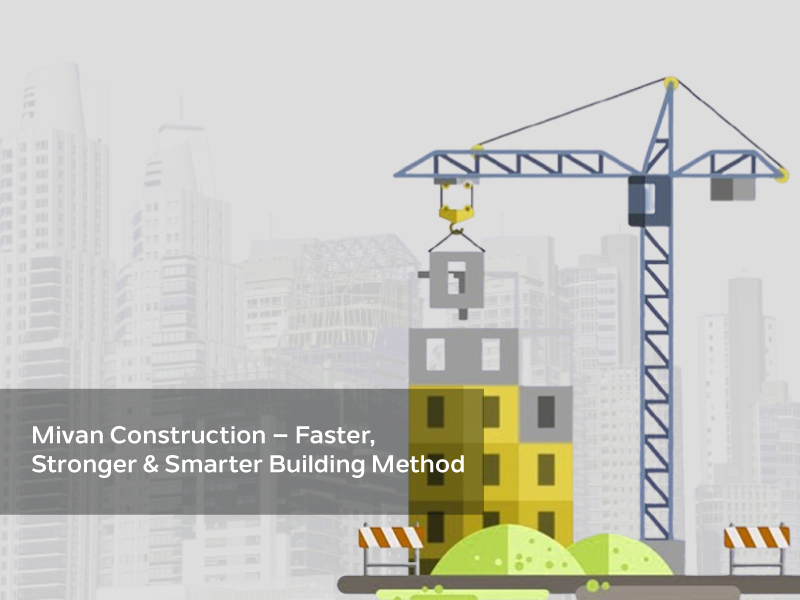When you’ve been in the building trade for decades, you start to notice patterns. Some ideas come in with noise and vanish in a year or two. Others quietly take root, and before you know it, they’ve changed the way we build forever. Mivan Construction is in that second category.
I still remember the first time I saw a Mivan system in action — it was back in the early 2000s, on a mid-rise residential project that was behind schedule. They brought in these shiny aluminum panels, laid them out like a giant puzzle, and within days, full floors were taking shape. For someone used to brick-and-mortar delays, it was like watching a well-oiled machine at work.
In simple words, Mivan Construction is an approach that uses precision-made aluminum formwork systems to pour entire walls, slabs, and columns in one go. Instead of piecing together a building like a patchwork quilt, you’re casting it as one solid block — what we call a monolithic concrete structure.
It’s fast. It’s neat. And when done right, it’s solid enough to stand for generations. But it’s not magic — it’s a combination of engineering discipline, planning, and the right tools.
2. The Origins of Mivan Construction
If you’ve been around the industry long enough, you’ll know that most “new” construction methods have roots going back decades. Mivan Construction is no exception. The system was developed by a European company called Mivan in the late 20th century, originally to speed up housing projects where large numbers of identical units had to be built in tight timelines.
The idea was simple but brilliant — instead of relying on wooden or steel formwork that needed constant adjusting, create a lightweight, reusable aluminum formwork system that could be assembled quickly, locked in place, and then used again hundreds of times.
The method found early adopters in places like Malaysia, Hong Kong, and later India, where rapid urban growth demanded faster high-rise construction methods. Here in India, I watched Mivan really take off after the mid-2000s, especially in cities where developers were racing to deliver thousands of apartments in record time with the help of modern construction management software.
It was more than just speed, though. The consistent, smooth finishes from the panels meant less plastering and less time spent on touch-ups. In an industry where every day of delay costs money, that’s a big deal.
Bonus: Top Features of Luxury Apartments in Delhi That Buyers Demand
3. Understanding the Mivan Process
Over the years, I’ve walked countless construction sites, and I can tell you — the magic of Mivan Construction isn’t in the pouring of concrete, it’s in the preparation. You don’t just show up and start.
Here’s how it typically works:
Step 1 – Panel Design and Fabrication
Before a single panel reaches the site, every wall, slab, and column is mapped out in detailed drawings. The aluminum formwork system is fabricated to exact measurements for the project. This precision is what gives Mivan its reputation for tight tolerances and consistent results.
Step 2 – Assembly on Site
When the panels arrive, they’re fitted together almost like an oversized Meccano set. Skilled crews assemble them so that they create a hollow mold for the concrete. Openings for doors, windows, and services are already planned and built into the mold.
Step 3 – Reinforcement and Concrete Pouring
Steel reinforcement bars are placed inside the formwork. Once ready, high-quality concrete is poured in — not in bits and pieces, but in one continuous operation that covers walls, slabs, and staircases together. This is what forms the monolithic concrete structure.
Step 4 – Curing and Removal
After the concrete sets (usually within 12–18 hours), the panels are carefully removed, cleaned, and stored for the next floor or section. Because they’re lightweight, handling them is faster and requires fewer workers compared to heavy steel forms.
📍 Noble Ayra: Luxurious 3 & 4 BHK High-Rise Living in Rohini Sector 32
Why it Works So Well
In traditional methods, you build walls first, then slabs, then come back for finishing. With Mivan Construction, you’re doing it all in one shot. That’s why timelines shrink dramatically. And because the surface finish is already smooth from the formwork, plastering is often minimal — just a skim coat in many cases.
4. Why Developers Are Choosing Mivan Construction
Over the years, I’ve sat in enough boardrooms and site offices to know one truth: developers chase certainty. They want to know how much it will cost, how long it will take, and whether the quality will satisfy buyers. Mivan Construction ticks those boxes better than most building methods I’ve seen.
For one, it shaves months off a schedule. I’ve seen projects that would normally drag on for 24 months wrap up in 14 or 15. That’s not just a time win; it’s a financial one. When you deliver early, you cut interest payments, reduce holding costs, and get to market before your competition.
It’s also easier to manage manpower. Instead of a scattered workforce doing bricklaying, plastering, and endless corrections, you’ve got a focused crew assembling the aluminum formwork system, pouring, and moving on. This makes scheduling cleaner and labour productivity higher.
And let’s not forget the buyers. Customers who walk into a Mivan-built home notice the difference — walls are straighter, finishes are smoother, and cracks are minimal even after years. For developers, that means fewer complaints and better word-of-mouth.
5. Technical Advantages of the System
If I strip away the business talk for a minute and look purely at the engineering side, Mivan Construction stands out for several reasons.
A. Monolithic Concrete Structure Strength
By pouring walls and slabs together, you remove the weak joints that occur in piecemeal construction. The result is a solid, joint-free mass that’s better at handling seismic activity and long-term wear.
B. Surface Finish Quality
The smooth aluminum panels give concrete surfaces that are nearly ready to paint. In some cases, you just apply a thin skim coat. That’s time and material saved right there.
C. High Reusability
Those panels? You can use them up to 200–250 times if you treat them right. That’s why Mivan Construction shines in large projects where the same floor plan is repeated.
D. Faster Cycle Time
Because you’re working floor by floor, a well-coordinated team can complete one cycle (assembly, pour, cure, remove) in just a few days. Compare that to traditional methods where walls alone can take weeks.
Bonus: 25 Luxury Interior Design Ideas to Instantly Elevate Your Home in 2025
6. Common Myths and Misunderstandings
After decades in this line of work, I’ve heard every excuse for not trying something new. Mivan is no different.
It’s too expensive.
Yes, the upfront cost for Mivan Construction is higher than for timber or conventional steel formwork. But that cost spreads out over hundreds of uses. On a big project, it works out cheaper in the long run.
You can’t be creative with design.
True, Mivan works best when layouts repeat. But I’ve seen skilled architects adapt it beautifully to creative designs. The trick is getting them involved early so formwork design matches the vision.
You need highly trained crews.
That’s only partly true. Yes, the first few assemblies need trained supervision. But once a team gets the hang of it, they work like clockwork. I’ve trained crews myself who went from clueless to confident in just two weeks.
7. Business Case Studies
I’ll give you two examples I’ve witnessed personally.
Case 1 – Mumbai High-Rise
A 25-storey residential tower planned for 24 months was completed in 14 using Mivan Construction. The developer saved nearly a year’s worth of interest on their construction loan, launched sales earlier, and sold out faster because buyers saw a solid, early-finished product.
Case 2 – Dubai Mixed-Use Tower
This one was a mix of offices and apartments. Here, Mivan helped the builder hit a tight deadline ahead of Expo 2020. The precision of the aluminum formwork system meant the interior fit-out teams could start sooner, overlapping with structural work — something that’s hard to do with brickwork walls.
8. Challenges and Practical Solutions
Every method has downsides. Mivan Construction is no exception.
High Initial Cost: Works best on large-scale projects where reuse justifies the investment.
Limited Flexibility: For projects with constantly changing floor plans, it’s not ideal. Solution? Standardize layouts where possible.
Maintenance of Panels: Aluminum can dent if handled poorly. Training crews to handle and store panels is non-negotiable.
9. The Role of Modern Building Technology
Here’s where things get interesting for the tech-minded crowd. Mivan Construction combines beautifully with tools like BIM (Building Information Modeling). You can design the entire project digitally, right down to the panel layout, and then feed that into procurement and scheduling software.
Some sites are now using IoT sensors to monitor concrete curing in real-time, adjusting timelines automatically. Even without going high-tech, the systematic nature of Mivan means fewer surprises during the build.
10. Mivan Construction in Sustainable Development
We all know the industry is under pressure to go greener. Mivan has a quiet but important role here:
Less Waste: Panels are reused hundreds of times, reducing material waste compared to timber formwork.
Longer Lifespan Buildings: The monolithic concrete structure stays solid for decades with minimal repair.
Fewer Finishing Materials: Smooth surfaces cut down on plaster and paint consumption.
Bonus: 4 BHK Apartments in Rohini: Why Smart Buyers Are Choosing Space Over Stress
11. The Future of Mivan in Global Construction
Looking ahead, I don’t see Mivan Construction disappearing any time soon. If anything, it’ll grow — especially in cities pushing vertical growth and faster delivery.
I also expect to see more automation alongside it. Robotic panel assembly and AI-based scheduling aren’t sci-fi dreams anymore. But even with all the tech, one truth will stay: the method works because it’s grounded in precision, planning, and a respect for the craft.
After fifty years around concrete dust and steel bars, I can say this — if you’re serious about speed, quality, and consistency, Mivan deserves a place in your toolkit.
Conclusion: Why Mivan Construction Deserves a Place in Modern Building
After spending most of my life walking half-built corridors, climbing scaffoldings, and watching cities grow, I can say without hesitation — Mivan Construction is one of the few methods that truly delivers on its promises.
It’s not just about speed, though the time savings are real and proven. It’s about building something that lasts. The monolithic concrete structure you get with Mivan doesn’t just look neat when you hand over the keys — it stays strong and stable years down the line. For developers, that means a better reputation. For buyers, it means fewer headaches.
Yes, the upfront investment is higher. Yes, it works best on projects with repetition. But when you plan it right, train your crew, and respect the process, the returns — both financial and in quality — outweigh the drawbacks.
In a world where deadlines are tighter, land is costlier, and buyers expect better, offers a balance of speed, quality, and efficiency that’s hard to match. Whether you’re an investor looking at timelines, an engineer chasing perfection, or a builder who takes pride in solid work, Mivan deserves a serious place in your toolbox.
I’ve seen many building trends come and go, but I believe this is one that’s here to stay — and I’m glad to have watched it change the way we build for the better.

